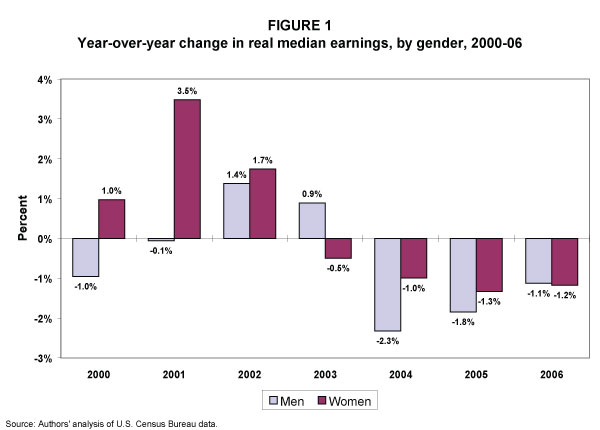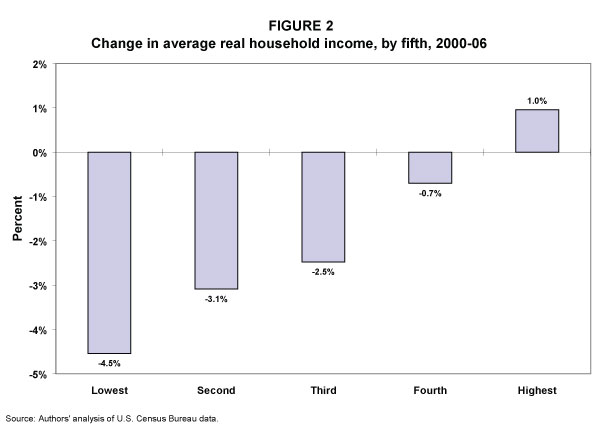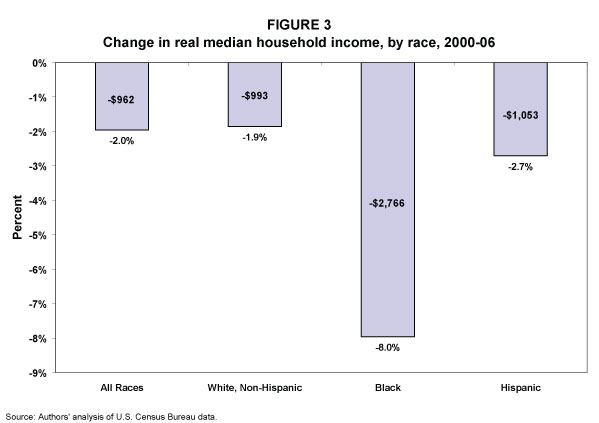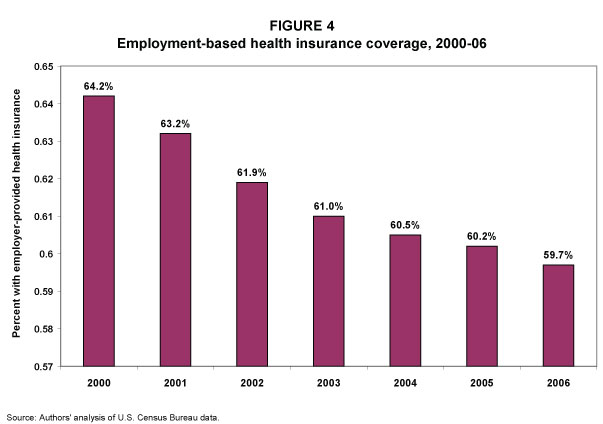From the ECONOMIC POLICY
INSTITUTE
Income Picture
August 28, 2007
Poverty, Income, and Health Insurance trends
in 2006
by Jared
Bernstein, Elise
Gould, and Lawrence
Mishel
Reflecting the fifth year of an economic expansion, the percent of
the nation in poverty fell last year, and the income of the median
household grew (after inflation) by about $360, or just under one
percent (0.7%), according to data released today by the U.S. Bureau of
the Census. This is the second year of real income gains for the
median household, and the first significant decline in poverty since
2000.
While both poverty and income have improved over the last few years,
it is disappointing that despite low unemployment and strong
productivity growth, these measures of living standards have yet to
recover to their levels of the previous business cycle peak in 2000.
In that year poverty was 11.3%, compared to 12.3% in 2006, an increase
in the poverty rolls of 4.9 million persons, including 1.2 million
children; median household income in 2006 was $48,201, about
$1,000 dollars (-2.0 %) below its 2000 level (in 2006 dollars). In other
words, economic growth over the last six years has totally bypassed the
typical middle-class household.
One negative trend persists: The share of Americans without health
insurance coverage once again increased, from 15.3% in 2005 to 15.8%
last year. There were 47.0 million uninsured Americans in 2006, up
2.2 million since its 44.8 million level in 2005. Since 2000, the
share of the population without health coverage has increased 2.1
percentage points, an increase of 8.6 million uninsured Americans.
Earnings of full-time workers
Reflecting the narrow extent to which the growing economy has been
showing up in the paychecks of many working-age households, median
annual earnings by full-time, year-round workers fell in 2006, for the
third year in a row, down about 1% for both men and women. Figure
1 shows annual earnings changes for these workers, who are, by
definition, working year-round. Despite their efforts, men’s
earnings have fallen 0.5% annually from 2000 to 2006, while those of
women were rose only 0.2% annually (and, as noted, have fallen steadily
since 2004).

The decline in median earnings in tandem with higher household income
at the median suggests that it was more hours worked and more people
working, and not higher wages that generated the income growth for
middle-class households last year.
The unequal distribution of growth between profits and compensation
is playing a critical role in this result. Our research on
corporate sector profits reveals that, had profits grown at the same
rate as labor income between 2005 and 2006, then compensation would have
been 1.1% higher for all workers: that is, the earnings declines among
male and female full-year workers last year can be accounted for by a
profit squeeze on wages.
Note also that this very weak wage performance has occurred while
productivity growth increased 3% per year (2000-06). While
economists and policy makers typically stress the positive performance
of such indicators as productivity, GDP, or low unemployment, these
earnings results clearly reveal that positive macro-conditions have not
led to wage growth for typical full-year workers, as customarily had
been the case.
Income inequality
The main reason for this disjuncture between productivity and
compensation is the increase in economic inequality. When growth
is unequally distributed, positive indicators like faster GDP or
productivity growth create only the potential for increased
living standards. In a climate where too many workers lack the
bargaining power they need to claim their fair share, we expect to see
patterns like those in Figure 2, which clearly shows how income
gains have been skewed toward those already at the top of the income
scale.
Between 2000 and 2006, the average income of the lowest fifth is down
4.5%, the middle fifth is down 2.5%, and only the top fifth is up, by
1%. Similarly, today’s report revealed that the share of income
going to the top fifth of households was 50.5%, the highest share on
record going back to 1967. The middle-income share was 14.5%, the
lowest on record. The bottom income share has been 3.4% since
2003, also an historic low.

Large losses for African
American households
Examining income changes for different ethnicities reveal important
disparities in economic outcomes. African Americans, whose median
household income was unchanged last year (up a statistically
insignificant 0.3%), have experienced particularly large losses since
2000 (see Figure 3), posting a loss of 8%, or about $2,800.

Working-age households
The median income of working-age households (those headed by
someone less than 65) was up 1.3% last year, the first year of income
growth since 2000. (This was driven exclusively by younger people, ages
15-24. Households headed by persons 25-64 saw only insignificant gains.1)
Even so, the median income for these working-age households is down 4%,
or about $2,400 lower than in 2000.
Historical landscape
How have poverty, income, and inequality developed over this business
cycle compared to earlier ones? Since the 1970s, poverty rates
have been largely insensitive to economic growth, due to factors ranging
from slower and less equally distributed growth, higher average
unemployment, diminished wage growth at the low end of the pay scale,
and the greater share of one-parent families, who are more vulnerable to
poverty.
These trends were reversed, however, for a period in the latter
1990s, as uniquely low unemployment, strong job creation, and faster
productivity growth enabled more workers to claim a larger share of the
growing economy.
Median household income, for example, rose less than 1% between 1967
(earliest available data) and 1995, before speeding up to an annual rate
of 1.9% (1995-2000). For minority households, median income growth
in the latter 1990s was especially strong, as was poverty reduction,
with the median income up 3.4% for African Americans and 5.3% for
Hispanics. Poverty for African American children fell an
unprecedented 10.7 percentage points, compared to 2.1 points for white
children.
The recession starting in 2001 halted these gains, and—as is
virtually always the case in a widespread downturn—poverty began to
rise and household incomes fell across the income scale, particularly
for working-age households (though high-income households were hit hard
by large capital losses in the early 2000s).
But when the recession ended in late 2001, poverty and median income
did not improve. To the contrary, both have worsened since then, as the
so-called jobless recovery made it too difficult for working
families—those that depend on paychecks, not stock portfolios—to
find enough employment in decent quality jobs.
Immigration's impact on
poverty
Some analysts have argued in the recent immigration debate that overall
poverty trends are now largely driven by a larger immigrant population.
The implication of this view is that poverty rates would improve and the
economy grows if immigration was diminished or comprised of more highly
skilled workers.
The data, however, do not bear out this view. While it is true
that immigrants have higher poverty rates than natives (11.9% vs. 15.2%
in 2006), immigrant poverty rates have fallen more quickly than that of
non-immigrants in recent years. This positive development over
time has to be balanced against the impact of a larger immigrant
population.
Last year, for example, immigrant poverty fell 1.3 percentage points,
compared to the statistically insignificant 0.2 percentage point decline
for non-immigrants.
Another way to demonstrate this point is to ask what the overall
poverty rate would have been in 2006 if the shares of immigrants and
non-immigrants were frozen at the population shares of an earlier
period. The difference between this simulated rate and the actual
rate allows us to determine any pressure on poverty rates due to more
immigrants. What we find is that if the immigrant share of
the population was currently the same as it had been in 1993 (the first
year Census poverty files include these data), the national poverty rate
would be essentially unchanged (only one-tenth of a percent higher).
Health insurance
The decline in insurance coverage in this country can be attributed to
declines in private coverage, particularly employment-based health
insurance. There is evidence of further unraveling of the
employer-based system:, the share of persons covered through work
(either their own or a family member’s employer) declined for the
sixth year in a row. As shown in Figure 4 below, employment
based coverage was 59.7% in 2006, down from 60.2% in 2005 and a total of
4.5 percentage points since 2000.

The declines in employment-based coverage were particularly striking
for dependents, as children under 18 without such coverage declined 1.2
percentage points over the year, continuing an annual decline since 2000
of 6.2 percentage points, from 65.9% to 59.7%. Public insurance
has not been strong enough to offset these declines, and so the percent
of uninsured children rose for the second year in a row. In the last two
years, the number of uninsured children rose by 1 million, from 7.7
million in 2004 to 8.7 million in 2006.
—Research assistance by James Lin.
|
Trust the Trend
The official U.S. poverty measure is roundly, and justifiably,
criticized by poverty analysts of all political stripes.
For details see this
testimony, but the current measure is generally agreed to be
both out of date and not an accurate reflection of who is and
isn’t facing material hardship.
But that by no means should lead analysts and policy makers
to dismiss today’s findings.
The most important information in this regard is not the
poverty level, which is likely inaccurate, but the trend in
poverty rates, which does provide an accurate depiction of the
extent to which economic growth is reaching low-income families.
The fact that poverty fell last year indicates that such
families made some economic progress. The fact that the
rate is still well above its 2000 level shows that little
progress has been made.
One reason to trust the trend is that much better measures of
poverty, developed by the Census Bureau to update the official
measure, closely track the trends in the official rate.
Census publishes 12 such measures, all based on variations in
recommendations made by the National Academy of Sciences.
These measures have not yet been updated to 2006, but their
average for 2005 was 13.4%, compared to the official rate,
12.6%. The average of the measures that most closely
reflect the NAS recommendations was 13.9%.
Most importantly, the trend in these more-accurate measures
moves with the official rate. For example, the Census
alternative measure that we judge to most-accurately reflect NAS
recommendations rose 1.3 percentage points since 2000, the same
growth rate of the official rate.
In short, the fact that the official poverty measure is one
percentage point above its 2000 level is stark evidence of the
extent to which the benefits of growth since then have not been
broadly shared.
|
Endnote
1. This observation is based on data
published today showing insignificant gains for each age category within
the 25-64 group. We cannot determine whether the change for the
group as a whole would be insignificant.
[Media Kit]
To view archived editions of INCOME PICTURE, click
here.
The Economic Policy Institute INCOME PICTURE is
published upon the annual release of family income data from the Census
Bureau.
EPI offers same-day analysis of income, price,
employment, and other economic data released by U.S. government
agencies. For more information, contact EPI at 202-775-8810.
|